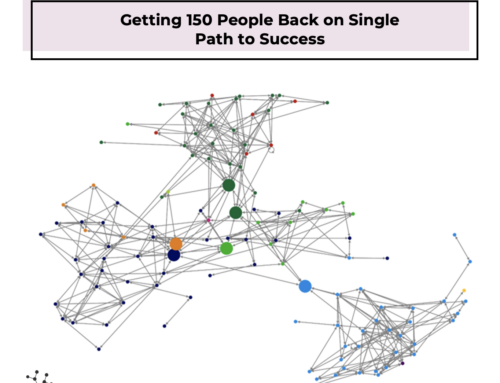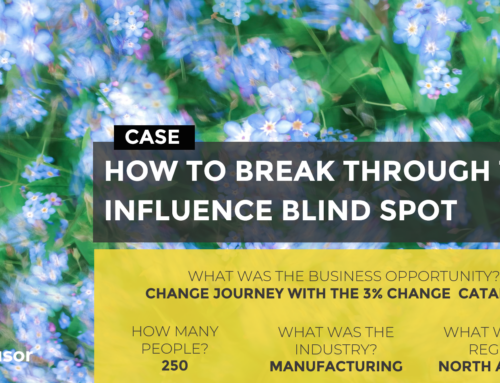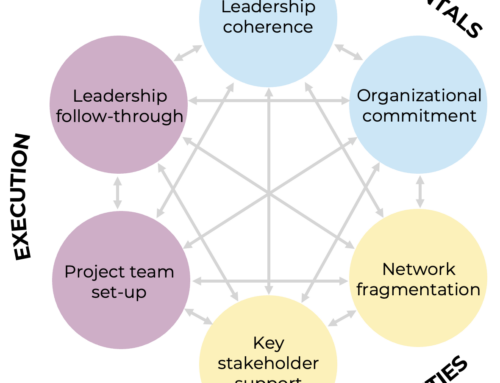Turn Resistance Into Commitment.
Engage Your Social Structures
ONCE UPON A TIME IN 2020 … AN HR ORGANIZATION STRUGGLED WITH ITS TRANSFORMATION ACTIVITIES
A 1,000+ HR organization of a large energy company could not deliver its value-adding strategic activities due to its long and hierarchical decision processes. As a result, leadership prepared to transform the HR organization towards a more self-managed way of working. Initially, leadership started sharing top-down messages sharing guiding principles and asking people to take their mandate. Somehow, leadership felt their message did not reach the whole of the HR organization.
Innovisor was brought in to assess the transformation readiness of the organization by listening to all 1,000 employees through a Co-Created Solution. This assessment was the baseline for a measurable action plan to accelerate the adoption of the new way of working.
The action plan for this HR organization answered two key questions:
- Who were the critical stakeholder groups for a successful adoption of the new way of working?
- What were the actions these stakeholders needed to be engaged on?

Widespread Negativity Was The Biggest Obstacle to the Transformation

The diagnostic of Innovisor showed that there was a worrisome level of resistance throughout the HR organization. Regardless of where the people were located geographically, structurally, or hierarchically in the HR organization, they did not feel positive about the coming transformation. The top-down messaging had not been successful, and a new approach was needed. To use the words once used by the communication expert Mike Klein: “why do we keep getting asked to do cascades when we know they don’t work?”. An approach focused on sense-making throughout the organization
How to Turn Transformation Resistance Into Commitment?
3% of the people were identified as key influencers in the organization. They were identified in peer-nominated influence networks as the most critical informal stakeholder group. The key influencers are the smallest group of people who can influence the biggest part of the organization. In this HR organization, 3% influenced 89% of their colleagues in the HR organization.
They were the right people for leadership to engage in with bottom-up change.
However, there was one big pain point! The key influencers were sceptical towards the transformation to a new way of working. And their concerns had ripple effects throughout the organizational networks.
Digging deeper, it turned out that the basis for key influencers’ scepticism differed between those key influencers who were managers and those who were employees:
- The managers did not feel properly informed about the transformation. They struggled to promote and role model the transformation.
- The employees did not feel trusted by their leaders, and therefore struggled to believe that the transformation would result in real empowerment.
Transformation Commitment With The Right People On the Right Actions
Transformation does not happen before it makes sense to the people, and this organization had yet to arrive at that point. To get there, the critical stakeholder groups were activated in targeted, evidence-based actions.

STEP 1: managers among key influencers needed upskilling in terms of understanding the transformation and adopting a transformation mindset
In a workshop, these managers were divided into groups of 4 to 5 persons. Each group was tasked with re-designing the communication plan in a way that more clearly conveyed the purpose and matter of the transformation. Each group then presented their output while one other group was assigned the role of questioning and critiquing, and a second group was assigned the role of highlighting the positives.
This workshop had a dual purpose. First, it ensured that all the information around the transformation initiative was reached and made sense to everyone. Second, it helped build connections between the managers with the most informal influence throughout the HR organization.

STEP 2: Managers among key influencers needed to build trust among their employees
There is no quick fix to do this. Rather, trusted relationships must be developed over time by demonstrating consistent reliability.
First, the managers among key influencers had set up fireside chats with the identified employees among the key influencers. These fireside chats created a psychologically safe space where they could use the evidence from the Organizational Network Diagnostic as a conversation starter.
The aim of the fireside chats was for the managers to ask and listen, not to debate or explain. To show that they listened, the managers repeated what they heard back to the employee and shared how their input would be acted upon. In addition, an open communication channel for the employees among key influencers was set up. This was a way for the transformation team to enable open and continuous feedback going forward.
ONCE UPON A TIME IN 2021 … WHEN AN HR ORGANIZATION SUCCEEDED WITH THEIR TRANSFORMATION ACTIVITIES
Three months after the upskilling and fireside chats, it was time to check on the impact of the action plan so far.
The organization utilized the Innovisor Change Tracker to measure how much the critical stakeholder groups were onboard with the transformation, and how they felt about it. As the voice of the people, it was crucial for the transformation team to find out whether the critical stakeholder groups experienced any improvement in the pain points uncovered in the organizational network diagnostic.
The Innovisor Change Tracker was a powerful way to engage with this smaller carefully selected group to solve the complex challenge of transforming to a new way of working.
The first Change Tracker showed that the targeted actions had paid off. The key influencers reported to feel much more informed about the transformation initiative, and they really started to understand the logic behind it. They also felt a greater sense of trust already.
The second Change Tracker confirmed that they were still on the right track. They felt that the logic of the new way of working was still clear. This improved engagement behind the transformation had the right ripple effect in the whole organization. A movement from the bottom-up was born .
It was of course still the transformation team who had the formal responsibility to succeed with this transformation. This team therefore needed to be conscious about how the engaged with the critical stakeholder groups. In particular, the key influencers became more mindful of their behavior. This insight from the Innovisor Change Tracker helped the transformation team to co-create the activities with key influencers so these influencers could recognize themselves in the activities.
This is how only a small group of people reached the hearts and minds of all 1,000 HR professionals. Succeeding with the transformation in only 14 months.
Do you like our articles? Subscribe to our newsletter.








